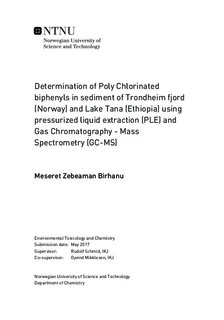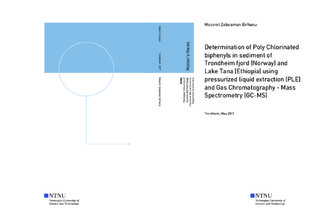| dc.description.abstract | The presence of polychlorinated biphenyls (PCBs) in the environment is of great concern, as they are compounds that are hazardous to the environment and human health. Environmental investigations of PCBs can be challenging as the analytes are found in trace amount, thus, it is important to have high sensitive and selective method for the determination of PCBs in environmental samples. In this work, an analytical method for the determination of PCBs in marine sediment samples was tested on sediment samples from Trondheim fjord, Norway, and Lake Tana Bahir Dar, Ethiopia. The samples were extracted by pressurized liquid extraction (PLE) and analyses were carried out by gas chromatography coupled with mass spectroscopy. The method made it possible to quantify the Dutch seven target PCBs (indicator PCBs) in marine sediments.
In the Trondheim fjord, from out of the Dutch seven indicator PCBs, six PCBs were found and quantified in samples from Trondheim Bay ranging from 13 - 141 ng/g in dry sediment weight, four PCBs are found and quantified in samples from Steinkjer ranging from 10.5-28.5 ng/g in dry sediment weight, and only PCB 118 is quantified in samples from Verdal fjord with amount of 14.1 ng/g in dry sediment weight. Samples from Ethiopia have only two quantified PCBs ranging from 10.8 14.4 ng/g in dry sediment weight. In all sediment samples the amount of PCB found is under the Effect Range Medium (ERM). ERM value for PCB is 180ng/g. Also according to the Norwegian climate and pollution agency (Klif), all sediment samples lies in moderately polluted (17-190ng/g) group. This indicates all study areas are environmentally safe relative to PCB contamination.
The analytical method was shown to have an acceptable instrumental precision, LOD ( 3 5 ng/g in dry weight), LOQ (10-14 ng/g in dry weight), and linearity (r2= 0.97), while the method remains to be further developed in order to improve the accuracy and selectivity. Specially, PCB 28 and PCB 31 were overlapping and not separated in this study. Therefore, further work is recommended to be done in order to achieve a reliable method for the determination of PCBs in marine sediment samples using PLE and GC-ECD (gas chromatography electron capture detector, which has high selectivity for PCBs) or tandem mass spectroscopy. May be a column of 60m is likely to improve the selectivity of the analyte, which is therefore recommended to test. | |

